Interview by Michelle Standley // Apr. 05, 2019
In honor of this month’s ‘Travel’ theme, we sat down with the New York and Berlin-based interdisciplinary artist Nina Katchadourian, whose work largely deals with the pleasures and pains of crossing borders. Among the most famous of these are her in-flight selfies, Lavatory Portraits in the Flemish Style (2011), in which she used the materials on hand in an airplane bathroom to transform herself into 15th-century Flemish portraits. Recently, I had the good fortune of catching her on both sides of the Atlantic, to see her solo show ‘Ification’ at Fridman Gallery in New York and her performance 1001 (Nights) at the Volksbühne in Berlin. What I discovered is that beneath the playful surface of her work there lurks, if not a subtle pathos, a tremor of unease. In addition to her recent solo show, her mid-career survey ‘Nina Katchadourian: Curiouser’ (2017-2018) made the rounds at several museums in the United States. Her contribution to the Armenian pavilion at the 2015 Venice Biennale, Accent Elimination (2005), was a six-channel video installation featuring her and her parents working with a speech coach either to eliminate or adopt each other’s accents. The exhibition earned the Golden Lion for Best National Participation.
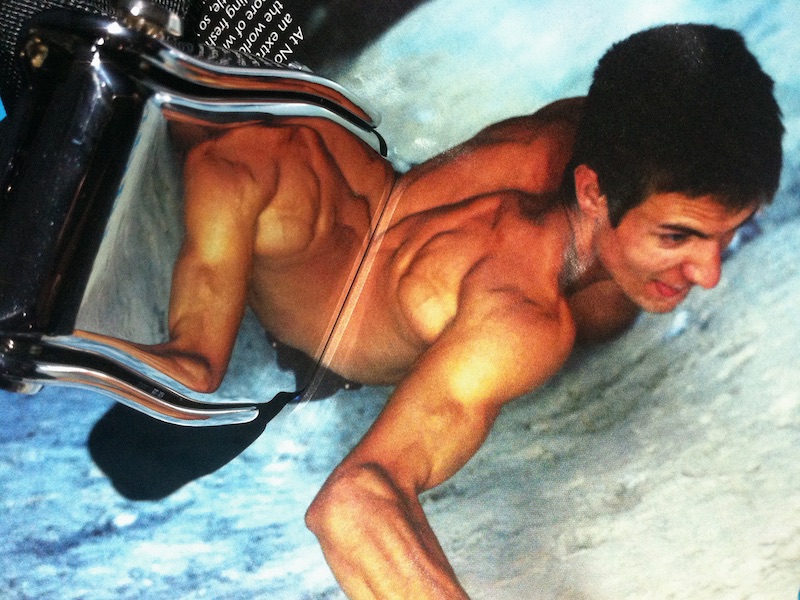
Nina Katchadourian: Centaur, 2012 (‘Seat Assignment’ project, 2010–ongoing) // Courtesy of the artist, Catharine Clark Gallery, and Fridman Gallery
In person, Katchadourian is affable, self-deprecating and, not surprisingly, very funny. She intersperses her narration by impersonating herself or an imagined stranger’s reaction to a situation, using a slightly high-pitched voice of an indeterminate origin, the sort of which you hear in her video Recarcassing Ceremony (2017) or in her live performance 1001 (Nights). The accent is impossible to place. This is most likely because it exists only in Katchadourian’s richly-imagined, alternate world, in which spiders need their webs repaired with thread (The Mended Spiderwebs Series, 1998) or popcorn machines speak in Morse code (Talking Popcorn, 2001).
Michelle Standley: With ‘Travel’ as our theme, perhaps there’s no better place to start than with Seat Assignment, specifically with the Lavatory Portraits in the Flemish Style, which became an Internet sensation. How did you get the idea for that project? And why Flemish portraits, specifically?
Nina Katchadourian: Why Flemish? I had the same question for a long time too. There was a flight when I was in the bathroom and thought: “Wow! I’ve never made a costume. Maybe I’ll try that. So what do I have to work with? Tissue paper seat covers, my scarf and some kind of pose.” Then I got back to my seat and looked at it. I did not recognize myself. I reminded myself of a 15th-century Flemish painting. I thought, “That’s weird. Why did that happen?” Then I had a trip six months later to New Zealand, which I knew would be a really good opportunity to make more of them because I’d have a lot of time. So I did. I made a lot more of them. And the question kept hanging there: why Flemish portraits?
The best answer that I have so far is that there is so much in Seat Assignment that is trying to contend with the social space of being on a plane. When you’re in a bathroom on a plane, it’s the only moment of privacy, the only space you have with yourself. And I think that what for me is so remarkable about these 15th-century Flemish paintings is that you have this feeling that you are looking at somebody alone with themselves. There’s this incredible, beautiful stillness, privacy, a sense of intimacy, a feeling that you’re close to this person but they do not realize that you are not there.
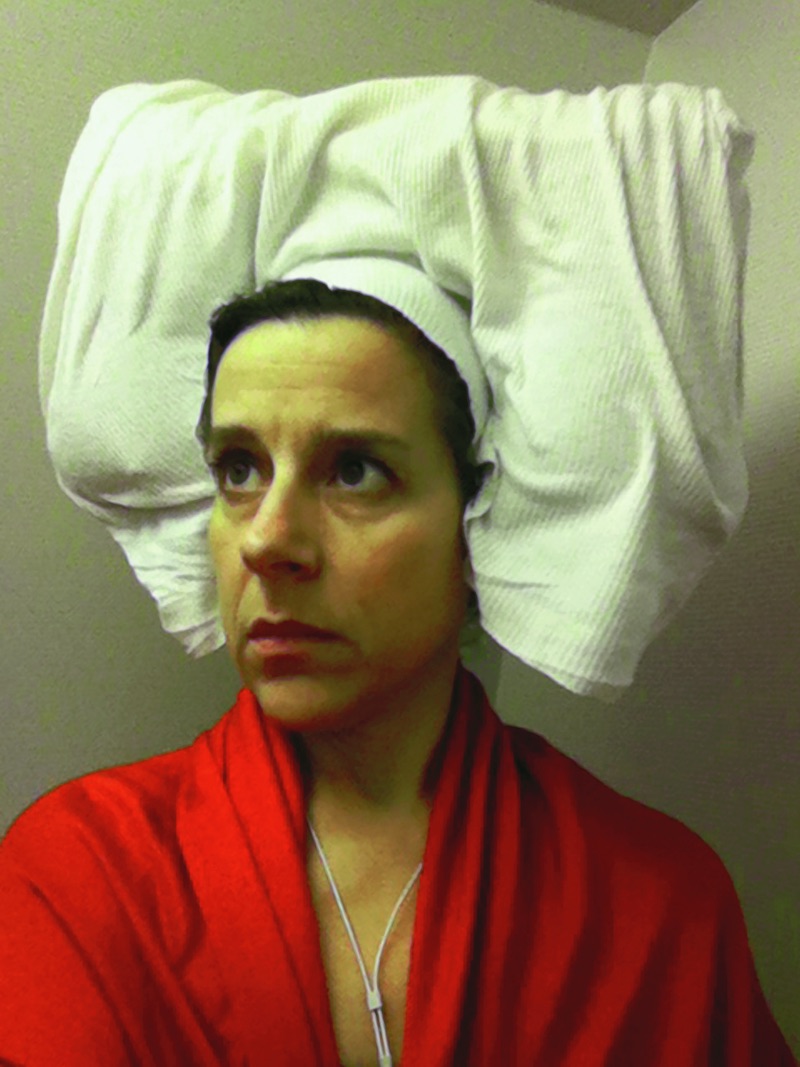
Nina Katchadourian: Lavatory Self-Portrait in the Flemish Style #8, 2011 (‘Seat Assignment’ project, 2010–ongoing) // Courtesy of the artist, Catharine Clark Gallery, and Fridman Gallery
MS: Perhaps part of the popularity of the in-flight Flemish portraits is that they play with the tension that you feel on an airplane not only from the lack of privacy but also from the lack of individuality. There’s nothing like an economy-class flight to remind you that you are part of a herd, a cog in a machine, easily replaceable. Your portraits, by contrast, suggest that in the airplane bathroom you can reveal your authentic self, as someone special, distinctive, a member of a historical elite even.
NK: Yes, I think that’s a good point. That’s all true. But I also think that one reason that people respond to these photographs is because they see a transformation that they find convincing, even if it’s transparent that I am using paper towels in a bathroom. People often say, “You look so Flemish!” And I tell them, “Actually, I really don’t.” The body positions are often wrong. One of the ones that has been reproduced more than any other is Lavatory Self-Portrait in the Flemish Style #12, in which I am doing a little bit of an over-the-shoulder look. You would never see that position in this period. It’s kind of sloppy in many ways. I’m not matching particular paintings. I’m trying to get at what makes them feel Flemish. It’s also kind of thrilling to me, using this contemporary tool of the cellphone. I think people have often liked that contrast, that unlikely result of this tool that we all know well, that the results of that tool and the circumstances add up to something really unexpected.
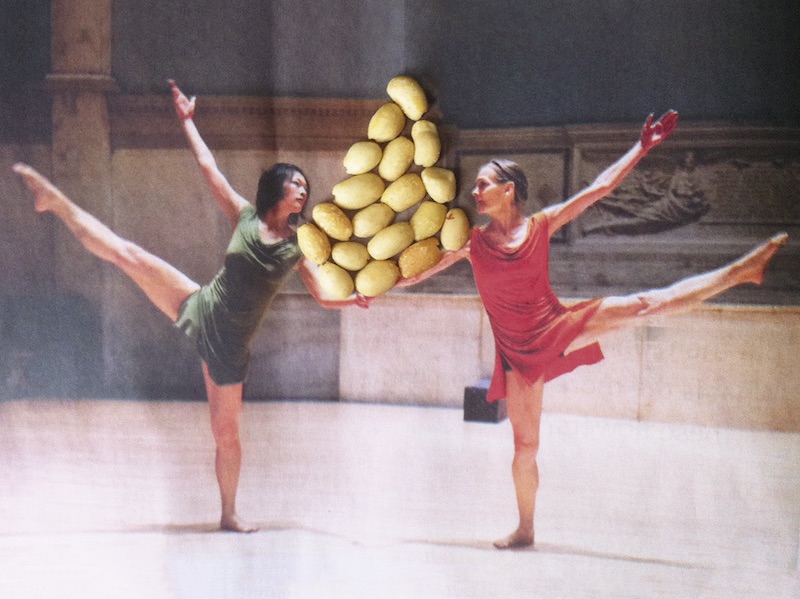
Nina Katchadourian: Dancers, 2012 (‘Seat Assignment’ project, 2010–ongoing) // Courtesy of the artist, Catharine Clark Gallery, and Fridman Gallery
MS: You look at many of these images from Seat Assignment, especially if you see them in isolation from one another, and your first reaction might be: “Oh, these are really silly: peas lined up to look like an outdoor sculpture, wafers standing on end to resemble the Twin Towers, a seat belt buckle used to spy on your seat-mate.” But when you view the photographs side-by-side, in one space, you can sense that there’s an undercurrent of tension, even fear, residing beneath the apparent absurdity. To what extent is Seat Assignment about fear or maybe even a way for you personally to deal with the stress of flying?
NK: That’s a really big deal for me and it’s important that in this project there are moments when the playfulness or levity is undercut by anxiety. This is a moment in travel, in air travel especially, where there is so much suspicion, so much looking askance at your neighbor, so many instances of awful racial profiling, absurd reactions like “My God, this person is reading something with Arabic writing on it. They might be a terrorist!” Travel or crossing borders is filled with a lot more anxiety than it used to be. But then there’s this other kind of fear that I always feel strongly at take-off, landing, and turbulence: “Oh my god, I’m inside a tube made of metal, with all of these people and I don’t know them and we are hurtling through space at crazy speeds.”
Seat Assignment is also a way of coping with the boredom and anxiety, because there is no happier place that I know than when I am deeply dug into making something. The micro-adjustments and teeny-tiny things that have to be sort of wrangled with fingers to make these pictures is really pleasurable for me. Like sewing. It is very absorbing. I get pulled out of those anxieties that we just talked about. Or maybe another way of putting it is that the tiny space that I’ve been allotted becomes really huge, because suddenly it’s like my world is only this space. But a lot is happening in that little world. So the tray table can be like a universe of possibilities, if I am on a roll.
But, in another way, and in kind of a cool way, flying is like time travel. It is still sort of magical to me. It has this miraculous quality. I cannot believe that I can wake up in Brooklyn and then fall asleep in Berlin at night. It is amazing to me. I have not lost that sort of thrilly-sense of it. When I was a kid we used to migrate as a family from California to Finland to spend the summers there, because of my mom’s family and our longstanding family’s place there. That trip was full of all this anticipation and excitement. My brother and I would always be like, “Oh, we’re gonna get on a plane!”
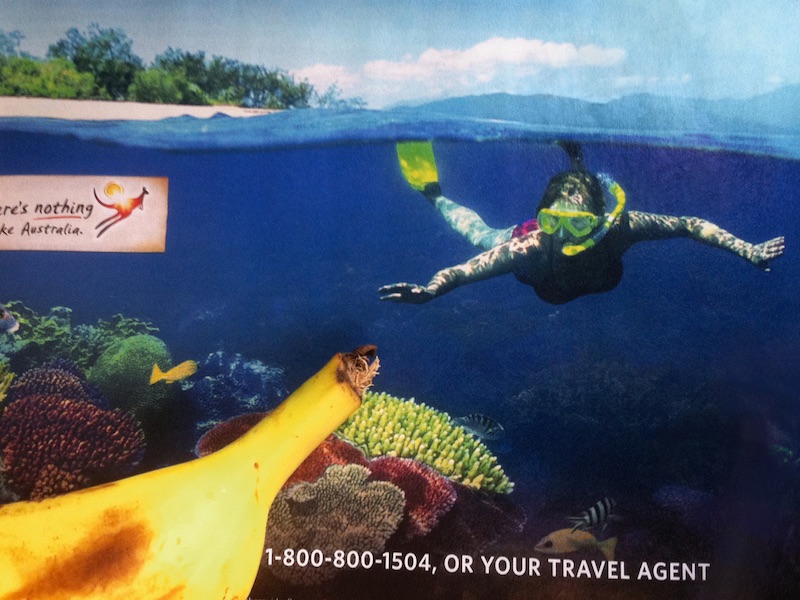
Nina Katchadourian: Bananafish, 2013 (‘Seat Assignment’ project, 2010–ongoing) // Courtesy of the artist, Catharine Clark Gallery, and Fridman Gallery
MS: Seat Assignment is not the only piece in which you use a subversive brand of humor to deal with the tensions involved in crossing borders. We could talk about your map series, but here I am thinking of Accent Elimination or more recently you exhibition ‘Der Krawall, Die Überraschung und Das Seepferdchen’ (2018) at Die Raum in Berlin, in which you staged scenes with objects like teddy bears and seahorses to help conquer and express the difficulties involved in learning German’s gendered nouns. Both projects are on some level concerned with the anxieties related to learning a new language, in a new home. What’s the link for you between language or language acquisition and belonging? Between language and cultural identity?
NK: Good question. It’s funny. The phrase that immediately came to mind is “mother tongue.” Growing up, we spoke Swedish with my mother and English with my father and English when we were all together. Swedish is my mother’s mother tongue. I still hate it when she speaks English to me. There are language spaces that I’d say feel very homey to me. And Swedish is one of those spaces. Or speaking Swedish with my mother is one of those spaces.
And now, it’s interesting to me, being here [in Berlin], and having to contend with this feeling of trying to get a hold on German. Last summer’s show (‘Der Krawall, Die Überraschung und Das Seepferdchen’) was an attempt to force myself to plunge into that, into a self-assigned language school. I am feeling very self-conscious of my own Americanness and not-from-hereness and my accent and all of those things when I try to speak German.
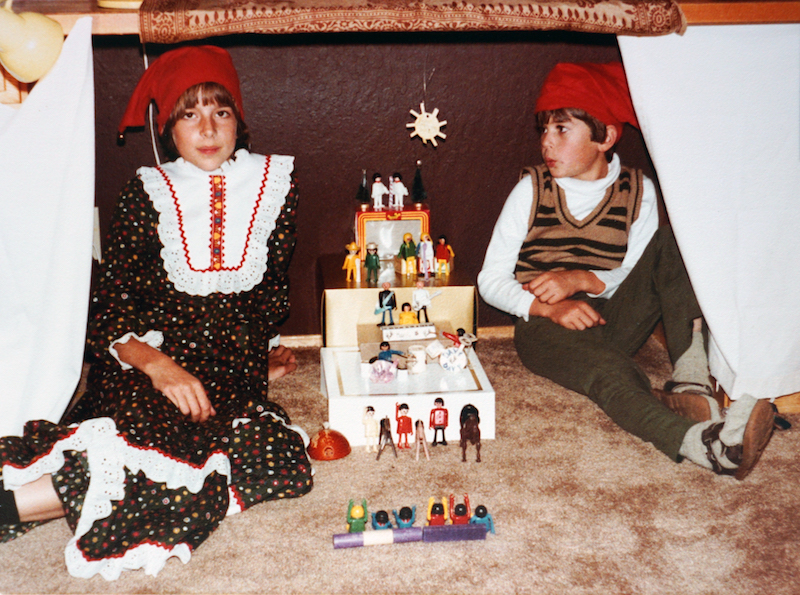
Nina Katchadourian, The Recarcassing Ceremony, 2016 (still), video with sound, 24:24 minutes // Courtesy of the artist, Catharine Clark Gallery, and Fridman Gallery
MS: But why humor to confront these themes? I can easily imagine another approach, a more direct, confrontational one.
NK: Well, one reason is that humor is very inviting. It is generous, inclusive, very much like “Come on in. Come closer.” And then once I’ve got you here, now that I have you, I can whisper something else in your ear that might not have been at all the thing that you thought we were going to end up talking about. But I also feel really strongly about the fact that there is not something simple about humor, that it is not just a joke. I am interested in the fact that you sometimes find something funny that is at the same time full of all sorts of conflict.
This humor question comes up a lot. There’s something in the art world, because I am female and there’s this humor thing; it is sometimes actually a problem. There’s a gendered quality to this and I wonder if on occasion my work has not been taken as seriously as it should have been because these things are circulating together somehow. I’ve basically forbidden words like “quirky” or “whimsical” to be used in a press release or in a review, if I can help it. Those adjectives just do not get applied to male artists. But I like the word humor. I like the word playful. Eccentric, even.
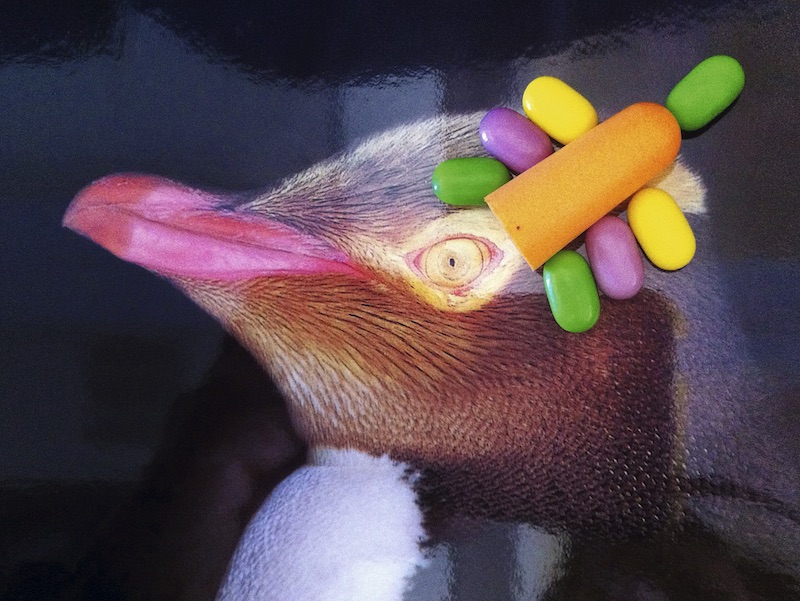
Nina Katchadourian: Snack Eyed Penguin Male, 2011 (‘Seat Assignment’ project, 2010-ongoing) // Courtesy of the artist, Catharine Clark Gallery, and Fridman Gallery
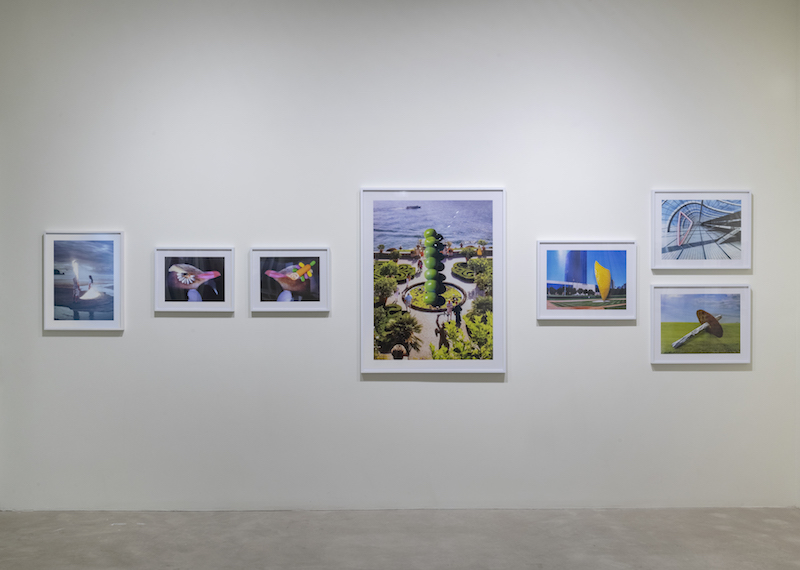
Installation view of Nina Katchadourian: ‘Ification’, Feb. 24–Mar. 31, 2019 // Courtesy of the artist and Fridman Gallery, New York, Photo by Adam Reich
MS: Because “whimsy” says “flighty” or “superficial”?
NK: It sounds unmotivated. Projects may start with experiments and spontaneity, like with Seat Assignment, but at the end I am a harsh editor who is cutting pictures out that aren’t good, who is deciding on some and not others. They are not all equal. There is a lot of rigorous thinking, editing, arranging and debating with myself. I don’t have any interest in pushing the humor out of the work; you know, on some level you are going to do what you do, and I think that you have to do those things that reflect who you are temperamentally. Why would I snuff this out?!
This article is part of our monthly topic of ‘Travel.’ To read more from this topic, click here.























